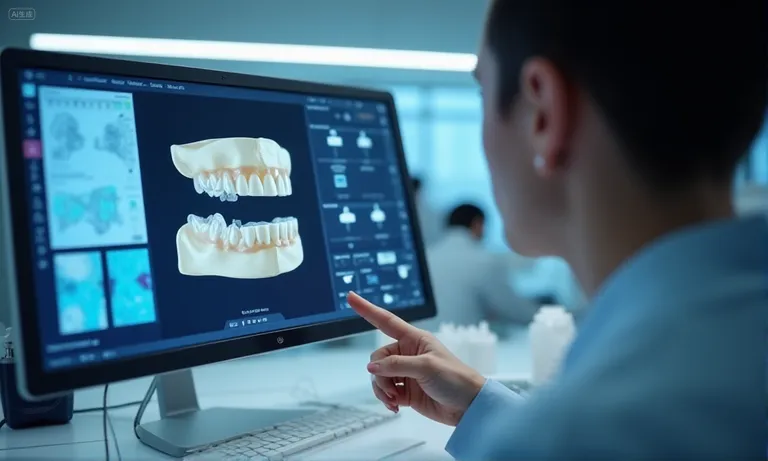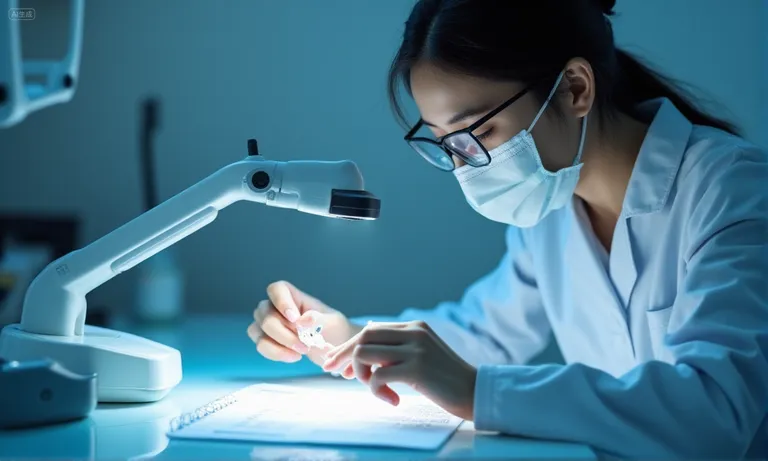Selecting the right dental lab for complex implant cases means choosing a partner with proven expertise, reliable processes, and collaborative discipline. Multi-unit, full-arch, or hybrid restorations demand higher precision; even small workflow errors can multiply into costly delays. A dependable lab provides not only technical accuracy but also predictable outcomes through standardized QA and transparent support.
Key factors for evaluation include:
- Implant specialization and track record: documented success with complex restorations.
- Digital workflow integration: compatibility with CAD/CAM and digital impressions.
- Material quality and consistency: trusted use of titanium, zirconia, and hybrid systems.
- Turnaround and reliability: predictable lead times and low remake rates.
- Risk control and compliance: ISO/FDA/CE-certified materials and clear documentation.
- Collaboration and communication: dedicated account support and responsive updates.
By focusing on these dimensions, procurement leaders reduce uncertainty, strengthen supplier partnerships, and secure consistent clinical outcomes. Clear evaluation standards make it easier to identify a dental lab that can manage complexity while also delivering sustainable value in long-term cooperation.
What Makes Implant Cases “Complex” in a Dental Lab Context
Complex implant cases in a dental lab setting usually involve factors that go beyond a single-unit crown. They require multi-layered planning, precise digital integration, and a deeper understanding of biomechanics. Common scenarios include multi-unit bridges, full-arch restorations, and hybrid prostheses, all of which demand higher accuracy and more coordinated workflows between clinics and labs. For buyers and procurement managers, recognizing these complexities is the first step toward choosing the right partner.

dental-lab-implant-complex-workflow
Typical challenges in complex implant workflows (multi-unit, full-arch, hybrid cases)
Complex workflows often include restoring multiple implants that must align seamlessly. Multi-unit and full-arch cases require a higher level of precision in angulation, occlusion, and soft tissue management. Hybrid restorations bring added complexity because they combine multiple materials and techniques, demanding cross-functional coordination.
- Multi-unit frameworks: risk of misfit increases exponentially with unit count.
- Full-arch restorations: require strict occlusal balance to avoid long-term complications.
- Hybrids: involve metal frameworks plus aesthetic veneering, often with higher risk of chipping or misalignment.
Key differences between simple vs. complex implant restorations
While single-unit crowns are relatively straightforward, complex implant cases introduce new layers of risk:
- Accuracy tolerance: a single-unit crown can tolerate minor adjustments, but a full-arch cannot.
- Workflow length: complex cases often require multiple design and verification steps.
- Interdisciplinary input: they usually involve both surgical and prosthetic planning, making lab-clinic communication more critical.
| Factor | Simple Implant Crown | Complex Implant Restoration |
|---|---|---|
| Units involved | Single | Multi-unit / full-arch |
| Adjustment tolerance | Moderate | Very low |
| Material handling | Basic zirconia/metal | Multiple material systems |
| Workflow complexity | Low | High, multi-step |
Why complex cases require specialized dental lab support
The higher the complexity, the lower the margin for error. A minor misalignment in a full-arch framework can lead to complete remake. Specialized labs offer advanced CAD/CAM tools, validated multi-material workflows, and experienced technicians who understand the risks unique to implant-supported prosthetics. This reduces remake rates and ensures predictable delivery. Procurement managers who underestimate this complexity often face hidden costs in delays, remakes, or patient dissatisfaction.
In our experience as an overseas dental lab, supporting clinics with full-arch and hybrid cases, the difference lies in preparation and precision. Labs accustomed to complex workflows not only prevent errors but also provide smoother collaboration. That trust becomes a deciding factor for long-term partnerships.
Key Criteria for Choosing the Right Lab for Complex Implant Cases
Choosing the right dental lab for complex implant cases comes down to measurable standards: proven implant specialization, technician expertise, digital workflow compatibility, turnaround reliability, and strict quality assurance. Labs that consistently meet these criteria reduce remake rates, streamline communication, and deliver predictable outcomes. For procurement managers, applying these filters early prevents costly surprises later.

dental-lab-quality-control-implant-case
How to assess implant experience and specialization (crowns, bridges, hybrids)
Not all labs handle the same case complexity. A lab may excel at single-unit crowns but struggle with full-arch hybrids. When evaluating, ask whether the lab has documented cases of multi-unit restorations, hybrid prostheses, and screw-retained bridges. Experienced labs usually have specialized design teams and a history of repeat implant orders. That history signals consistency, not trial-and-error learning.
What technician expertise and certifications indicate reliable skills
Technician expertise matters when it comes to complex frameworks. Certifications such as CDT (Certified Dental Technician) or ISO-accredited training programs show that skills meet international standards. Beyond certificates, look for labs that continuously train on updated CAD/CAM software and implant library systems.
- CDT or equivalent regional certification
- ISO-accredited training or compliance courses
- Documented experience with implant-specific systems (Straumann, Nobel Biocare, etc.)
How digital workflow compatibility (STL, CAD/CAM) ensures efficiency
Digital compatibility reduces friction. Complex implant cases often require multiple design iterations. A lab that can accept STL files, align with major CAD/CAM systems, and integrate digital implant libraries avoids delays. The smoother the file exchange, the faster the production cycle.
- Confirm the lab accepts STL and open-source formats.
- Check for CAD/CAM system alignment (3Shape, Exocad).
- Verify digital implant library compatibility.
Why turnaround time and consistency are critical for implants
Complex implant restorations cannot afford unpredictable delivery times. A delay in one framework may disrupt surgical appointments or patient satisfaction. Labs that commit to defined lead times—and prove they meet them—are safer partners. Consistency matters more than occasional speed; a stable 10-day turnaround is better than unpredictable 5-to-15 day variability.
How remake rate and QA policy impact implant success
High remake rates erode both profit and trust. Complex implants leave little room for error, so labs should have QA protocols that include fit checks, digital verification, and pre-shipment reviews. Comparing remake rates across labs helps procurement teams estimate hidden costs.
| Lab Metric | Industry Average | Reliable Lab Benchmark |
|---|---|---|
| Remake rate (implants) | 6–10% | ≤ 3% |
| Average turnaround time | 12–15 days | 7–10 days |
| Digital compatibility | Partial | Full STL + CAD/CAM |
Labs like Raytops Dental Lab position themselves as overseas partners by embedding multi-step QA in every shipment, which directly lowers remake risk for clients managing high-value implant cases. This consistency is often the factor that determines whether procurement teams trust a long-term partnership.
How to Evaluate Material Quality and Aesthetic Reliability
Material quality and aesthetic reliability directly affect the long-term success of complex implant restorations. The right choice of titanium, zirconia, or hybrid materials ensures biocompatibility, strength, and predictable esthetics. Reliable labs not only select proper materials but also enforce shade-matching protocols and durability testing, which helps procurement managers confirm the lab’s ability to deliver consistent results in demanding cases.

dental-implant-materials-zirconia-titanium
Best materials for complex implant restorations (titanium, zirconia, hybrids)
Different implant restorations demand different material properties. Titanium remains the gold standard for frameworks because of its strength and biocompatibility. Zirconia is often used for esthetic areas due to its natural translucency. Hybrid combinations allow strength plus esthetics, especially in full-arch or multi-unit restorations.
- Titanium frameworks: high strength, reliable osseointegration support.
- Zirconia crowns and bridges: esthetic, stain-resistant, suitable for anterior cases.
- Hybrid prostheses: combine titanium base with layered zirconia or acrylic for balance.
How labs ensure long-term durability and biocompatibility
Reliable labs test not only fit but also mechanical stability. For instance, frameworks undergo milling accuracy checks, and zirconia is sintered under controlled conditions to prevent micro-fractures. Biocompatibility certifications, such as FDA or CE marking for raw materials, confirm safety. Labs with clear documentation of source materials reduce risk for procurement managers.
How to verify aesthetic consistency for anterior implant cases
Anterior implants are judged by patient satisfaction, not just fit. Shade matching, translucency, and surface texture must be consistent across multiple units. Labs that keep digital shade libraries and routinely cross-check against physical shade guides can achieve higher predictability. Procurement managers should request photographic records of past anterior implant cases to verify lab standards.
How labs manage shade matching and translucency for implants
Esthetic consistency is one of the hardest aspects to control. Comparing how labs manage shade matching reveals their maturity.
| Aesthetic Factor | Low-Maturity Lab Approach | Reliable Lab Practice |
|---|---|---|
| Shade selection | Manual single shade pick | Digital shade scanning + physical guide |
| Translucency control | Basic zirconia use only | Layered zirconia with customized cutback |
| Documentation | None | Photos + digital records per case |
Procurement teams that prioritize these benchmarks find fewer remakes and less chairside adjustment. Raytops Dental Lab, as an overseas partner, often emphasizes material traceability and shade-matching workflows to help clinics handle demanding anterior implant cases with higher confidence.
Costs, ROI, and Outsourcing in Complex Implant Cases
Cost evaluation for complex implant restorations should not stop at the unit price. True ROI depends on balancing upfront cost, long-term reliability, and flexibility in outsourcing. Procurement managers who include remake rates, shipping efficiency, and hidden chairside adjustment costs in their calculation gain a more realistic view of the total investment. Overseas outsourcing, when managed properly, often provides better ROI through lower unit pricing and scalable production capacity.

dental-lab-outsourcing-cost-roi
Common pricing structures for complex implant restorations
Labs structure pricing differently for multi-unit and full-arch restorations. Understanding these categories helps procurement teams benchmark fairly:
- Per-unit pricing: most common for single crowns or bridges.
- Framework + unit bundle: fixed price for titanium or zirconia frameworks plus crowns.
- Full-arch packages: flat pricing for All-on-4 or hybrid prostheses.
- Premium esthetics surcharge: additional cost for anterior shade customization or layered zirconia.
How to balance upfront cost with long-term reliability
Cheaper pricing can look attractive, but remakes and delays quickly erode ROI. A lab that charges slightly more but maintains remake rates below 3% often proves more cost-effective. Procurement teams should calculate “true cost per delivered case,” factoring in remake frequency, chairside adjustment time, and patient rescheduling. A lab with proven QA reduces these hidden costs.
When outsourcing overseas can improve ROI and delivery flexibility
Outsourcing to overseas labs offers two major benefits: lower unit costs and scalability. Many clinics and DSOs find that by outsourcing multi-unit or full-arch work, they gain not only cost savings but also the ability to handle peak demand without local bottlenecks. The key is to evaluate shipping times and customs clearance reliability.
| Outsourcing Factor | Domestic Lab | Overseas Lab (Reliable Partner) |
|---|---|---|
| Unit pricing (multi-unit) | $450–600 | $250–350 |
| Average remake rate | 5–7% | ≤ 3% |
| Capacity for surge orders | Limited | High (scalable) |
| Shipping time | 1–3 days | 4–7 days with express clearance |
Working with an overseas partner like Raytops Dental Lab allows procurement teams to convert cost savings into higher ROI, while still maintaining quality and predictable delivery windows. This flexibility is often what helps DSOs scale complex implant programs without overshooting budgets.
How to Reduce Risks in Complex Implant Outsourcing
Outsourcing complex implant cases can unlock cost and capacity advantages, but it also introduces risks. The most common issues include miscommunication, inconsistent quality, and regulatory gaps. Buyers can reduce these risks by partnering with labs that follow international compliance standards, enforce strict QA protocols, and maintain clear documentation workflows. Reliable outsourcing is not about avoiding risk entirely but about controlling and minimizing it.

dental-lab-implant-outsourcing-risk-control
Typical risks in outsourcing complex implant cases
Risks usually arise from gaps in control and communication. The more complex the case, the higher the probability that small errors escalate into costly remakes.
- Quality inconsistency: frameworks that do not fit precisely.
- Regulatory misalignment: materials not properly certified for specific markets.
- Communication gaps: design intent lost in translation or file incompatibility.
- Logistics delays: customs clearance or courier bottlenecks.
How to validate lab’s quality control and compliance standards (ISO, FDA, CE)
Validating compliance is one of the most effective risk-control measures. Labs with ISO 13485 certification demonstrate adherence to medical device quality standards. FDA or CE compliance for materials ensures biocompatibility and traceability. A trustworthy lab will provide documentation of these certifications proactively. From a procurement perspective, these verifications reduce liability and ensure that restorations can be legally used in regulated markets.
Best documentation practices to minimize errors
Strong documentation processes directly reduce remake risk. Each step, from digital file submission to final shipment, benefits from clear, standardized protocols.
- Submit digital files in agreed formats (STL with embedded metadata).
- Include written design notes and annotated scans.
- Confirm lab provides case documentation: material batch numbers, QA logs.
- Ensure shipping documents match regulatory requirements of the receiving country.
Labs like Raytops Dental Lab integrate compliance and documentation workflows into every shipment, which reassures overseas buyers that risks are proactively managed, not just addressed when problems arise. This kind of disciplined process helps procurement managers sleep better knowing cases will pass both clinical and regulatory checks.
What Collaboration Practices Ensure Long-Term Success
Long-term success in complex implant outsourcing is not only about materials or pricing but about how well both sides collaborate. Effective communication, dedicated support, and a clear cooperation framework build resilience into the partnership. Clinics and procurement managers who prioritize structured collaboration reduce delays, prevent misunderstandings, and secure more predictable outcomes.

dental-lab-collaboration-long-term-success
How clear and timely communication prevents costly delays
Communication breakdowns are one of the biggest hidden costs in implant outsourcing. Delays often occur because small clarifications are missed or case details are assumed instead of confirmed. Labs that establish structured update protocols—such as daily status reports or shared case-tracking dashboards—help prevent costly misunderstandings. For procurement managers, this means fewer last-minute surprises and more confidence in scheduling.
Why dedicated account support matters for complex workflows
Dedicated support staff act as the bridge between technicians and procurement teams. Instead of routing every question through a general inbox, labs with account managers provide faster responses and smoother coordination.
- Faster troubleshooting: direct contact resolves design or shipping issues quickly.
- Workflow consistency: one account manager learns the clinic’s preferences over time.
- Escalation clarity: urgent issues go straight to someone accountable.
How to build long-term success with your dental lab
Sustainable collaboration is built on mutual visibility and trust. Long-term partnerships often include trial projects, then expand into standardized frameworks for communication, invoicing, and QA review. Reliable labs share both strengths and limitations early, which helps set realistic expectations. When both sides commit to process transparency, success is easier to repeat at scale.
From our position as an overseas dental lab, we see that the clinics who invest in structured collaboration—regular calls, documented preferences, and transparent feedback loops—experience fewer remakes and smoother scaling. For procurement leaders, this is the difference between a transactional vendor and a true long-term partner.
Conclusion
Selecting the right partner for complex implant restorations requires more than comparing prices. It means evaluating technical expertise, material reliability, risk management, and collaboration practices that ensure predictable outcomes. Clinics and procurement managers who approach outsourcing this way reduce hidden costs and achieve higher treatment consistency. By working with an overseas dental lab that combines digital workflow compatibility, strict QA, and transparent communication, buyers can gain both cost efficiency and confidence in delivery. This balance is what turns outsourcing from a tactical decision into a sustainable long-term advantage.


